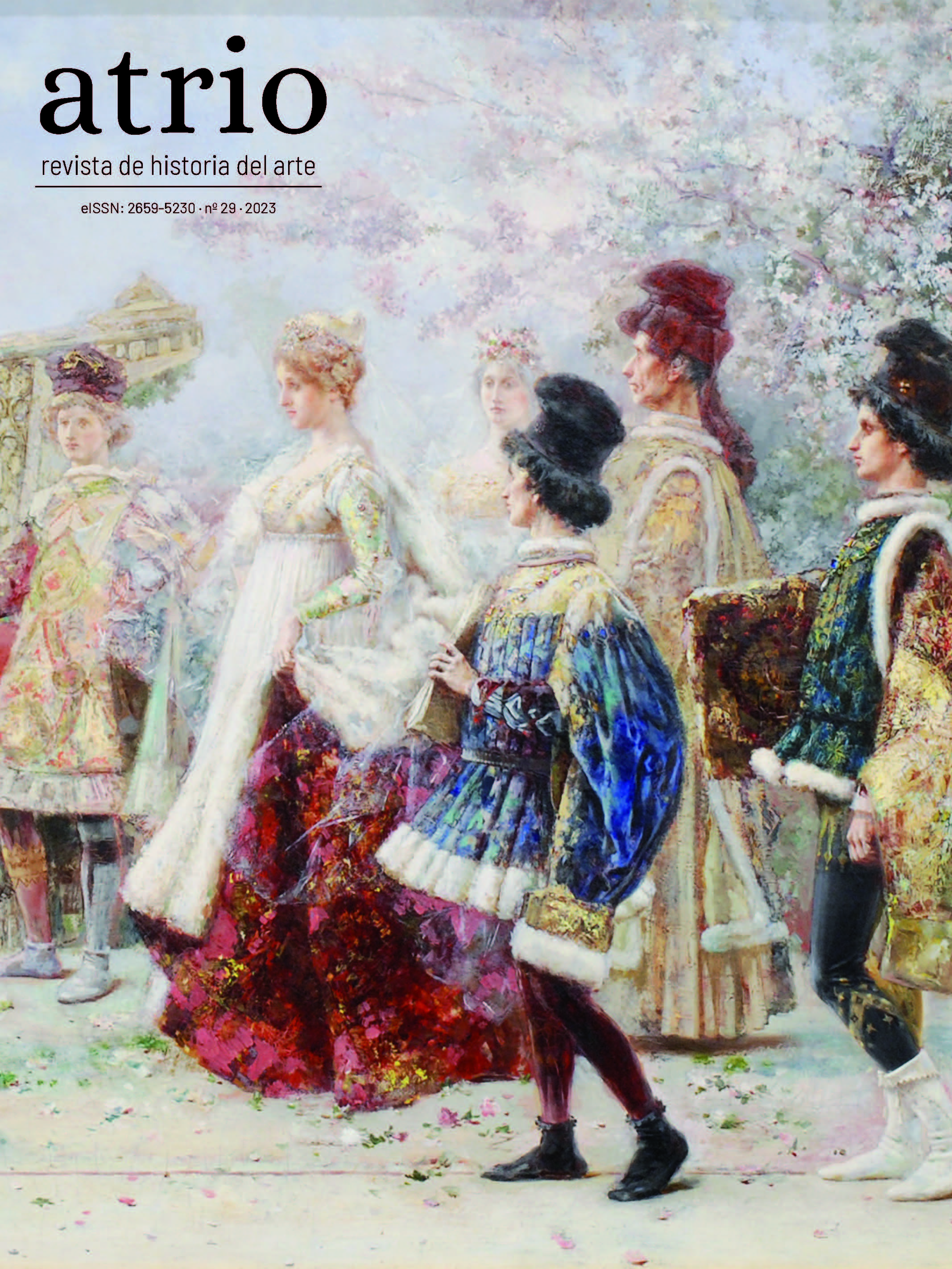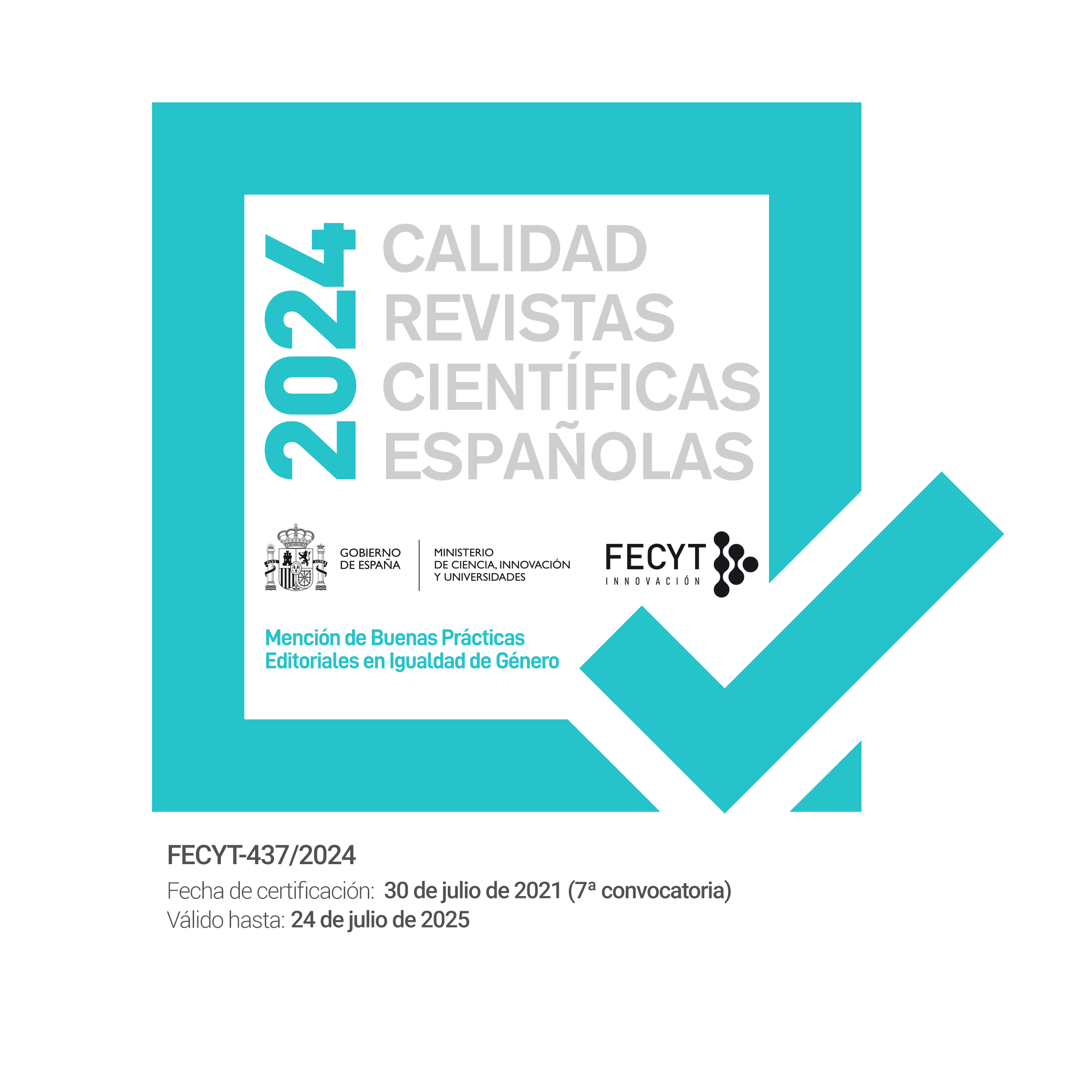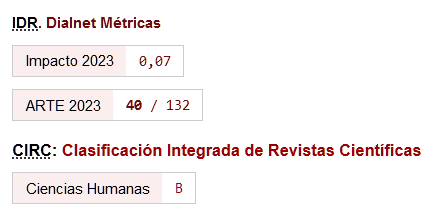Neo-Renaissance Painting in the Work of Salvador Sánchez Barbudo through the Painter José Villegas Cordero.
DOI:
https://doi.org/10.46661/atrio.7741Keywords:
José Villegas Cordero, Salvador Sánchez Barbudo, Fortunian Painting, XIX Century Painting, Romanticism, Neo RenaissanceAbstract
The lack of research of the origin of neo-renaissance themes cultivated by some painters at the end of the 19th century and the beginning of the 20th, results in some confusion when it comes to titling, identifying and describing scenes. The article sheds light on the provenance of these themes, deepening an understanding of the importance that Venetian medieval history had in the inspiration of nineteenth-century artists. It also delves into the stylistic change that these themes prompted in the careers of José Villegas Cordero and Salvador Sánchez Barbudo, analyzing their work from a formal point of view. Villegas was one of the most influential painters of the time. He introduced the neo-renaissance to the Spanish colony of Rome and was closely followed by his disciple, Sánchez Barbudo, in subject and pictorial quality.
Downloads
References
Fuentes bibliográficas:
Alcolea Albero, Fernando. Pintores Españoles en Londres (1775-1950). Menorca: CreateSpace Independent Publishing Platform, 2014.
Bietoletti, Silvestra, y Michele Dantini. L’Ottocento Italiano. La storia, Gli artisti, Le opere. Florencia: Giunti Gruppo Editoriale, 2002.
Byron, Lord George. Marino Faliero, Doge of Venice: an historical tragedy. Londres: John Murray, 1842.
Castro Martín, Ángel, coord. Villegas (1844-1921). Córdoba: Publicaciones de la obra social y cultural Cajasur, 2001. Publicado en conjunto con una exhibición del mismo título, organizada y presentada en el Museo de Bellas Artes de Sevilla del 22 de febrero al 30 de marzo de 2001 y en la Sala de Exposiciones museísticas Cajasur del 5 de abril al 6 de mayo de 2001.
Martorelli, Luisa, coord. Domenico Morelli e il suo tempo. 1823 1901 dal romanticismo al simbolismo. Nápoles: Electa Napoli, 2005. Publicado en conjunto con una exhibición del mismo título, organizada y presentada en el Castel Sant’Elmo de Nápoles del 29 de octubre de 2005 al 29 de enero de 2006.
Molmenti, Pompeo. La Dogaressa di Venezia. Turín: Roux e Favale, 1884.
Norwich, John Julius. Historia de Venecia. Granada: Almed, 2004.
Oriani, Girolamo. Il Trionfo della Dogaressa di Venezia nel secolo XV. Venecia: Girolamo Oriani, 1874.
Rodríguez Pardo, Juan, coord. Salvador Sánchez Barbudo. Jerez de la Frontera: Ayuntamiento de Jerez, 1997. Publicado en conjunto con una exhibición del mismo título, organizada y presentada en la Gerencia Municipal de Urbanismo de Jerez de la Frontera del 23 de septiembre al 15 de octubre de 1997.
Stanley, Edgcumbe. The dogaressas of Venice: the wifes of the doges. Londres: T.W. Laurie, 1910.
Temple, A.G. Modern Spanish Painters. Londres: Arnold Fairnairns and co., 1901.
Zilcken, Philip, coord. Prima Esposizione Internationale d’Arte della cita di Venezia, 1895. Catalogo Illustrato. Venecia: Tipo-litografico Fratelli Visentini, 1895. Publicado en conjunto con una exhibición del mismo título, organizada y presentada en i Giardini publici di Castello de Venecia del 22 de abril al 22 de octubre de 1895.
Fuentes periodísticas:
“Bodas de oro en el siglo XV.” La Ilustración Artística, 9 de enero de 1888.
“Bodas de un príncipe español. del s. XV. Cuadro de S.S. Barbudo.” La Ilustración Artística. Suplemento Artístico, 1 de diciembre de 1886.
Solsona, Justo. “La pintura española en Buenos Aires.” La Ilustración Artística, 7 de agosto de 1905.
Viallet, Bice. “Salvador Sánchez Barbudo.” Vita d’Arte: rivista mensile d’arte antica e moderna, vol. 15 (1916): 197-200.
Referencias web:
“19th century European paintings.” consultado el 2 de noviembre de 2013. https://www.sothebys.com/en/auctions/ecatalogue/2003/19th-century-paintings-n07886/lot.121.html
“Retrato de Dogo”, consultado el 10 de octubre de 2017. https://www.salaretiro.com/es/lote/17O2-2196-2196/680-33042-retrato-de-dogo.
Published
How to Cite
Issue
Section
License
Copyright (c) 2023 Carmen Chofre García

This work is licensed under a Creative Commons Attribution-NonCommercial-ShareAlike 4.0 International License.
Los autores/as que publican en Atrio. Revista de historia del arte están de acuerdo con los siguientes términos:
- Los autores/as conservan los derechos de autor y garantizan a la revista el derecho de ser la primera publicación del trabajo al igual que licenciado bajo una licencia de Creative Commons Attribution-NonCommercial-ShareAlike 4.0 International License que permite a otros compartir el trabajo con un reconocimiento de la autoría de este y la publicación inicial en esta revista.
- El autor/a o cedente del material que se entrega para su publicación autoriza a la revista para que publique, sin obligación alguna (económica o de otra naturaleza), el contenido del referido manual tanto en formato papel, como en digital, así como en cualquier otro medio. Esta cesión de uso del material entregado comprende todos los derechos necesarios para la publicación del material en la revista. Quedan garantizados, simultáneamente, los derechos morales del autor
- El autor/a o cedente es plenamente consciente y está de acuerdo con que todos o cualesquiera de los contenidos proporcionados, formarán una obra cuyo uso se cede a la revista para su publicación total o parcial.
- El autor/a o cedente garantiza ser el titular de los derechos de Propiedad Intelectual sobre los contenidos proporcionados, es decir, sobre el propio texto e imágenes/fotografías/obras fotográficas que se incorporan en su artículo.
- El autor/a o cedente asegura y garantiza: (i) que todo el material enviado a la revista cumple con las disposiciones legales aplicables; (ii) que la utilización de cualquier material protegido por derechos de autor y derechos personales en la concepción del material se encuentra regularizada; (iii) que obtuvo las licencias de derechos, permisos y autorizaciones necesarias para la ejecución del material, inclusive los derechos de imagen, si fueran aplicables; y (iv) que el material no viola derechos de terceros, incluyendo, sin limitarse a estos, los derechos de autor y derechos de las personas.
- El autor/a o cedente, exime a la revista de toda y cualquier responsabilidad con relación a la violación de derechos de autor, comprometiéndose a emplear todos sus esfuerzos para auxiliar a la revista en la defensa de cualquier acusación, medidas extrajudiciales y/o judiciales. Asimismo, asume el abono a la revista de cualquier cantidad o indemnización que esta tenga que abonar a terceros por el incumplimiento de estas obligaciones, ya sea por decisión judicial, arbitral y/o administrativa.













